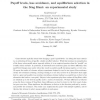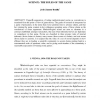228 search results - page 11 / 46 » Expected Reachability-Time Games |
DAGSTUHL
2006
13 years 10 months ago
2006
Game theorists typically assume that changing a game's payoff levels--by adding the same constant to, or subtracting it from, all payoffs--should not affect behavior. While t...
IWEC
2004
13 years 10 months ago
2004
Multi-modal tabletop applications offer excellent opportunities for enriching the education of young children. Read-It is an example of an interactive game with a multi-modal tangi...
FLAIRS
2010
13 years 11 months ago
2010
Dynamic changes in complex, real-time environments, such as modern video games, can violate an agent's expectations. We describe a system that responds competently to such vi...
IGPL
2010
13 years 7 months ago
2010
: Popper s suggestion of taking methodological norms as conventions is examined from the point of view of game theory. The game of research is interpreted as a game of persuasion, ...
BIRTHDAY
2009
Springer
14 years 3 months ago
2009
Springer
We introduce a new class of games, asynchronous congestion games (ACGs). In an ACG, each player has a task that can be carried out by any element of a set of resources, and each r...


